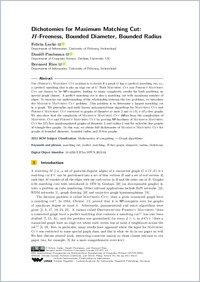Dichotomies for Maximum Matching Cut: H-Freeness, Bounded Diameter, Bounded Radius
BP2-STS
- Lucke, Felicia ORCID Université de Fribourg, Switzerland
- Paulusma, Daniel ORCID Durham University, United Kingdom
- Ries, Bernard ORCID Université de Fribourg, Switzerland
- 21.08.2023
Published in:
- 48th International Symposium on Mathematical Foundations of Computer Science (MFCS 2023) / Leroux, Jérôme ; Lombardy, Sylvain ; Peleg, David. - Schloss Dagstuhl - Leibniz-Zentrum für Informatik. - 2023, p. 64:1-64:15
English
The (Perfect) Matching Cut problem is to decide if a graph G has a (perfect) matching cut, i.e., a (perfect) matching that is also an edge cut of G. Both Matching Cut and Perfect Matching Cut are known to be NP-complete, leading to many complexity results for both problems on special graph classes. A perfect matching cut is also a matching cut with maximum number of edges. To increase our understanding of the relationship between the two problems, we introduce the Maximum Matching Cut problem. This problem is to determine a largest matching cut in a graph. We generalize and unify known polynomial-time algorithms for Matching Cut and Perfect Matching Cut restricted to graphs of diameter at most 2 and to (P₆+sP₂)-free graphs. We also show that the complexity of Maximum Matching Cut differs from the complexities of Matching Cut and Perfect Matching Cut by proving NP-hardness of Maximum Matching Cut for 2P₃-free quadrangulated graphs of diameter 3 and radius 2 and for subcubic line graphs of triangle-free graphs. In this way, we obtain full dichotomies of Maximum Matching Cut for graphs of bounded diameter, bounded radius and H-free graphs.
- Faculty
- Faculté des sciences économiques et sociales et du management
- Department
- Département d'informatique
- Language
-
- English
- Classification
- Computer science and technology
- Series statement
-
- Leibniz International Proceedings in Informatics (LIPIcs) ; 272
- License
- Open access status
- gold
- Identifiers
- Persistent URL
- https://folia.unifr.ch/unifr/documents/325849
Statistics
Document views: 85
File downloads:
- matchingcuts: 151
